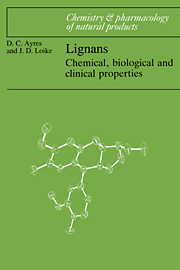Book contents
- Frontmatter
- Contents
- To students and colleagues in Westfield College, 1965–1984.
- Preface
- Glossary for lignans
- 1 Introduction
- 2 A registry of the natural lignans
- 3 Biological and clinical properties of podophyllotoxin and other lignans
- 4 Etoposide and Teniposide
- 5 Isolation, purification and initial characterisation
- 6 Determination of structure
- 7 Biosynthesis
- 8 Synthesis
- Botanical index
- General index
6 - Determination of structure
Published online by Cambridge University Press: 05 February 2012
- Frontmatter
- Contents
- To students and colleagues in Westfield College, 1965–1984.
- Preface
- Glossary for lignans
- 1 Introduction
- 2 A registry of the natural lignans
- 3 Biological and clinical properties of podophyllotoxin and other lignans
- 4 Etoposide and Teniposide
- 5 Isolation, purification and initial characterisation
- 6 Determination of structure
- 7 Biosynthesis
- 8 Synthesis
- Botanical index
- General index
Summary
This chapter will in the main concentrate attention on spectroscopic methods for establishing lignan structures, but complementary chemical methods will be mentioned as appropriate.
Ultraviolet absorption spectra
All lignans show a basic UV absorption pattern typical of aromatic compounds with three bands in the regions of 210, 230, and 280 nm which correspond to the singlet excited states defined by Platt (1949; see Murrell, 1971) as 1Ba,b; 1La and 1Lb respectively. As the greater majority of lignans are optically active these maxima may usually be correlated with those in circular dichroism (CD) plots (p. 000). Clearly this basic absorption pattern will be modified in compounds with additional conjugation including those lignans which are fully aromatic.
The most intense absorption maximum arising from a component of the 1B excitation in the region of 210 nm has a molecular extinction (ε) of about 5 × 104 but this is rarely recorded. Peaks in the range 220–240 nm (ε = 10 to 20 × 103) and at about 280nm (ε = 2 to 10 × 103) are of diagnostic value since the absorption is of sufficient intensity to allow monitoring at all stages of the isolation procedure (p. 000).
In lignans where there is no conjugation to or between the aryl groups the absorption at the longest wavelength is sensibly the sum of their molar extinction coefficients.
- Type
- Chapter
- Information
- LignansChemical, Biological and Clinical Properties, pp. 166 - 268Publisher: Cambridge University PressPrint publication year: 1990
- 1
- Cited by



